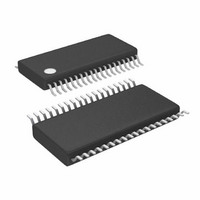LTC3855IFE#PBF Linear Technology, LTC3855IFE#PBF Datasheet - Page 16

LTC3855IFE#PBF
Manufacturer Part Number
LTC3855IFE#PBF
Description
IC CTLR DC/DC MULTIPHASE 38SSOP
Manufacturer
Linear Technology
Series
PolyPhase®r
Type
Step-Down (Buck)r
Datasheet
1.LTC3855EUJPBF.pdf
(44 pages)
Specifications of LTC3855IFE#PBF
Internal Switch(s)
No
Synchronous Rectifier
Yes
Number Of Outputs
2
Voltage - Output
0.6 ~ 3.3 V, 0.6 ~ 12.5 V
Current - Output
25A
Frequency - Switching
250kHz ~ 770kHz
Voltage - Input
4.5 ~ 38 V
Operating Temperature
-40°C ~ 125°C
Mounting Type
Surface Mount
Package / Case
38-TSSOP Exposed Pad, 38-eTSSOP, 38-HTSSOP
Lead Free Status / RoHS Status
Lead free / RoHS Compliant
Power - Output
-
Available stocks
Company
Part Number
Manufacturer
Quantity
Price
LTC3855
applicaTions inForMaTion
less than 1µA. When the SENSE pins ramp up from 0V to
1.4V, the small base currents flow out of the SENSE pins.
When the SENSE pins ramp down from 12.5V to 1.1V,
the small base currents flow into the SENSE pins. The
high impedance inputs to the current comparators allow
accurate DCR sensing. However, care must be taken not
to float these pins during normal operation.
Filter components mutual to the sense lines should be
placed close to the LTC3855, and the sense lines should
run close together to a Kelvin connection underneath the
current sense element (shown in Figure 1). Sensing cur-
rent elsewhere can effectively add parasitic inductance
and capacitance to the current sense element, degrading
the information at the sense terminals and making the
programmed current limit unpredictable. If DCR sensing
is used (Figure 2b), sense resistor R1 should be placed
close to the switching node, to prevent noise from coupling
into sensitive small-signal nodes. The capacitor C1 should
be placed close to the IC pins.
Low Value Resistors Current Sensing
A typical sensing circuit using a discrete resistor is shown
in Figure 2a. R
output current.
The current comparator has a maximum threshold
V
common mode range of the current comparator is 0V to
12.5V. The current comparator threshold sets the peak of
the inductor current, yielding a maximum average output
current I
peak ripple current, ∆I
value, use the equation:
SENSE(MAX)
R
SENSE
Figure 1. Sense Lines Placement with Sense Resistor
MAX
=
equal to the peak value less half the peak-to-
I
determined by the I
V
(MAX)
SENSE(MAX)
SENSE
+
∆I
R
is chosen based on the required
L
SENSE
2
. To calculate the sense resistor
L
TO SENSE FILTER,
NEXT TO THE CONTROLLER
LIM
C
OUT
setting. The input
3855
F01
Because of possible PCB noise in the current sensing loop,
the AC current sensing ripple of ∆V
needs to be checked in the design to get a good signal-to-
noise ratio. In general, for a reasonably good PCB layout, a
10mV ∆V
number to start with, either for R
applications, for duty cycles less than 40%.
For previous generation current mode controllers, the
maximum sense voltage was high enough (e.g., 75mV for
the LTC1628 / LTC3728 family) that the voltage drop across
the parasitic inductance of the sense resistor represented
a relatively small error. For today’s highest current density
solutions, however, the value of the sense resistor can
be less than 1mΩ and the peak sense voltage can be as
low as 20mV. In addition, inductor ripple currents greater
than 50% with operation up to 1MHz are becoming more
common. Under these conditions the voltage drop across
the sense resistor’s parasitic inductance is no longer neg-
ligible. A typical sensing circuit using a discrete resistor is
shown in Figure 2a. In previous generations of controllers,
a small RC filter placed near the IC was commonly used to
reduce the effects of capacitive and inductive noise coupled
inthe sense traces on the PCB. A typical filter consists of
two series 10Ω resistors connected to a parallel 1000pF
capacitor, resulting in a time constant of 20ns.
This same RC filter, with minor modifications, can be used
to extract the resistive component of the current sense
signal in the presence of parasitic inductance. For example,
Figure 3 illustrates the voltage waveform across a 2mΩ
sense resistor with a 2010 footprint for the 1.2V/15A
converter operating at 100% load. The waveform is the
superposition of a purely resistive component and a
purely inductive component. It was measured using two
scope probes and waveform math to obtain a differential
measurement. Based on additional measurements of the
inductor ripple current and the on-time and off-time of
the top switch, the value of the parasitic inductance was
determined to be 0.5nH using the equation:
If the RC time constant is chosen to be close to the
parasitic inductance divided by the sense resistor (L/R),
ESL
=
SENSE
V
ESL STEP
∆
(
I
voltage is recommended as a conservative
L
)
t
t
ON
ON
+
•
t
t
OFF
OFF
SENSE
SENSE
= ∆I
or DCR sensing
L
• R
SENSE
also
3855f













